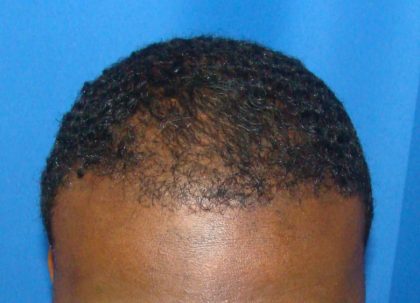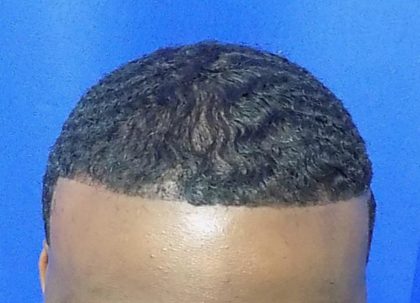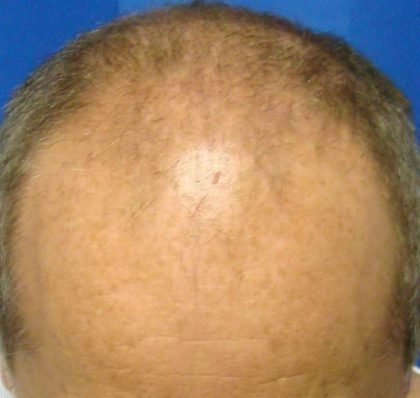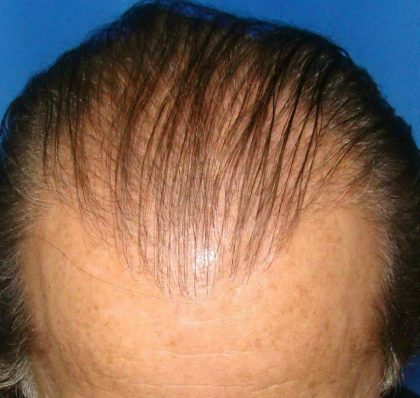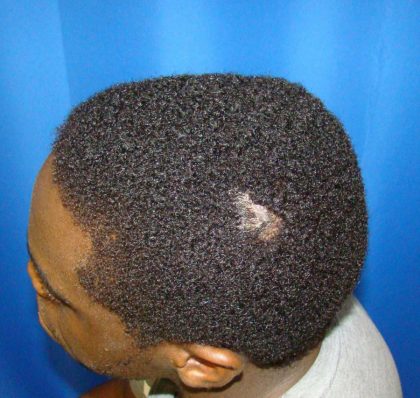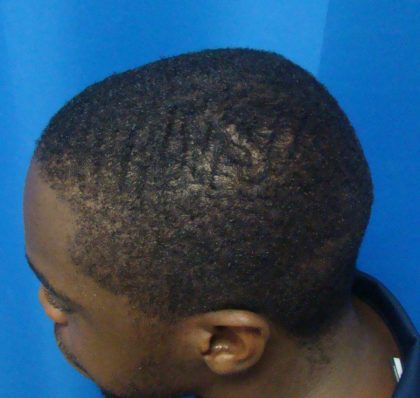Contents
- 1 A Natural-Looking Hairline
- 2 Before and After Photos
- 3 About Micrografts for Hair Restoration
- 4 What are the Benefits of Micrografts?
- 5 Who are the Ideal Candidates for Micrografts?
- 6 Personal Consultation
- 7 Preparing for Hair Restoration in Houston
- 8 The Procedure
- 9 Recovery
- 10 Results
- 11 What is the Cost of Micrografts in Houston?
- 12 References
A Natural-Looking Hairline
Micrografts are a type of hair transplantation procedure in which small grafts containing 1-2 hairs help to restore hair to areas of the scalp that are thinning or bald. These grafts are typically taken from the back or sides of the scalp, or where the hair is thicker, and then transplanted to the thinning area. The goal of the procedure is to create a natural-looking pattern of hair growth that blends in with the surrounding hair. Men in the early stages of male pattern baldness can benefit greatly from micrografts. These men are not alone; hair transplantation is the most requested surgical cosmetic procedure by male patients. [1]
Patients in Houston, Austin, and the surrounding areas in Texas are lucky to have a hair restoration specialist in their area. Dr. Goran Jezic has helped countless patients in Texas restore a full head of hair and take back their life! He believes that confidence starts by addressing thinning hair, patterned baldness, and all forms of hair loss. Don’t lose another hair from your head – call Houston Hair Transplant Center today! You can schedule your consultation by calling (713) 864-2300 or filling out our online form.
Check out our blog for more information about hair loss and hair restoration procedures and systems, all from Houston’s hair restoration specialists!
Before and After Photos
About Micrografts for Hair Restoration
The use of micrografts and minigrafts has significantly improved hair restoration in both aesthetic and reconstructive cases and has quickly become the preferred technique in most cases. The concept of using single-hair grafts is not new; in 1953, patients were treated to restore eyebrow hair loss! [2]
The use of micrografts and minigrafts allows for the creation of a more natural-looking pattern of hair growth that blends in with the surrounding hair. These small grafts, taken from the back or sides of the scalp where the hair is thicker, and transplanted to the area being treated.
While the transplanted hair will usually fall out within a few weeks, new hair should start to grow in its place within a few months. It may take several months to a year for the final results to become visible.
Dr. Jezic can treat his Houston, TX, patients more successfully because he employs the latest technologies in the world of hair restoration. One such technology for Follicular Unit Extraction (FUE) is the ATERA and another is the Neograft. ATERA is a hair restoration technology that mechanically harvests hair follicles and places them at equal depths and in proportional locations to promote the growth of a thicker, fuller head of hair. The system is minimally invasive and alleviates the demands placed upon the surgeon and patient with other outdated methods.
What is FUE?
Follicular Unit Excision (FUE) is the hair transplantation technique taking individual hair follicles from the donor area. In FUE, a small, round punch tool is used to remove each follicle individually, rather than removing a strip of tissue like in the traditional hair transplantation technique known as strip method. The punched-out follicles are transplanted to the recipient area, where they will grow into healthy, new hair.
What are the Benefits of Micrografts?
One of the main advantages of FUE is that it does not leave a linear scar, as the strip method does, at the back of the head, which can be a concern for some patients. Scarring from micrograft FUE is not visible once the patient has healed.
Furthermore, micrografts can help the hairline look more natural because they allow the surgeon to replicate the way that hair grows in a given area. For example, the hairline is typically denser with single hair follicles. The single hair transplant method provides a transition zone at the front of the hairline. By using a combination of micrografts and minigrafts, the surgeon can create a hairline that looks natural and blends in with the surrounding hair.
Improved Self-Confidence
Many people who are experiencing hair loss may feel self-conscious about their appearance and may have low self-confidence as a result. Micrografts for hair restoration can help to restore a more youthful, full head of hair, which may improve self-confidence and self-esteem.
A full head of hair may also have social and professional benefits. Some people may feel more confident and self-assured in social and professional situations when they have a full head of hair, which may lead to greater opportunities and increased success.
Enhanced Physical Appearance
A hair restoration procedure can help to restore a more youthful, attractive appearance, which can have a positive impact on a person’s overall physical and emotional well-being. Patients may experience more confidence in romantic situations and likely a better sex life.
Who are the Ideal Candidates for Micrografts?
The ideal candidates for a hair restoration procedure using micrografts are those who are experiencing hair loss due to male or female pattern baldness or other causes, such as scarring alopecia or certain medical conditions. [3] You should also have realistic expectations about the results of the procedure and be willing to follow post-procedure care instructions.
To be a good candidate for the procedure, you should have healthy hair growth on the back and sides of your scalp, as these areas are typically used as the donor sites for the transplanted hair. If you have advanced hair loss, you may not have enough donor hair available to achieve the desired results, although in some cases, the patient may be able to use a donor site other than the scalp. Dr. Jezic will discuss with you the possibility of donor hair from the beard, chest, or another location on your body during your consultation.
Personal Consultation
A consultation for a hair restoration procedure using micrografts typically involves:
- A thorough evaluation of your scalp, hair, and overall health
- A discussion of your medical history
- Disclosure of any previous hair loss treatments you have undergone
- A conversation about your goals for the procedure and any concerns you may have
During the consultation, Dr. Jezic will examine your scalp and hair to determine the extent of your hair loss and assess the quality and quantity of your donor hair. They may also take photos for your medical record and to help plan the procedure.
Dr. Jezic will discuss the details of the procedure with you, including the expected number of grafts needed, the expected results, the length of your procedure, and the potential risks and benefits.
Though hair loss can be a source of embarrassment for many patients, it is important to be honest and upfront with Dr. Jezic during the consultation to ensure that you receive the most accurate information and the best possible treatment plan.
Preparing for Hair Restoration in Houston
Here is a general overview of the steps you can take to create a successful outcome:
- Depending on the results of your consultation, Dr. Jezic may recommend that you have a medical evaluation to ensure that you are healthy enough to undergo the procedure and that your hair loss is not a temporary side effect of an underlying condition.
- We may have you stop taking certain medications, such as blood thinners or non-steroidal anti-inflammatory drugs (NSAIDs), to increase your safety during hair transplantation.
- You should avoid tobacco products for at least two weeks before the procedure to reduce the risk of complications.
- Alcohol should be avoided a few days leading up to your procedure
- You will need to arrange for transportation after the procedure, as you may not be in a position to drive after surgery.
The Houston Hair Transplant Center team will provide you with specific pre-procedure instructions which you should follow carefully to ensure the best possible outcome.
The Procedure
Micrograft surgery using NeoGraft is typically performed using local anesthesia to numb the area being treated.
First, we will prepare the donor area, either the back or side of the scalp, by partially or completely shaving the area. Then, using the NeoGraft device, Dr. Jezic will harvest individual hair follicles from the donor area. The ATERA and Neograft systems use a punch removal technique with suction. Dr. Jezic will carefully plan the placement of the grafts to ensure that they are placed at the correct angle and direction to mimic the way that hair naturally grows in that area.
Dr. Jezic and his team are able to implant up to 3,500 grafts, which will take around three hours. [4]
Recovery
Micrograft transplantation with NeoGraft has a shorter and easier recovery time than other methods of transplantation. Typically patients can expect a healing time of three to four days. [4] Patients may experience some swelling, redness, and discomfort around the donor and recipient sites; these side effects should resolve within a few days.
Results
The transplanted hair will typically fall out within a few weeks after the procedure. Do not worry – new hair should start to grow in its place within a few months. It may take several months to a year for the final results to become visible.
Patients will see a hairline that is natural-looking and will blend seamlessly with the surrounding hair. Your newly transplanted hair will grow and be styled just like your natural hair. No one will ever know that you’ve had a hair transplant, and isn’t that the goal? Look younger, increase your confidence, and enjoy life more completely after hair transplantation with micrografts!
What is the Cost of Micrografts in Houston?
The cost of a hair restoration procedure using micrografts will vary depending on several factors like the number of grafts needed, as well as any additional procedures that may be performed at the same time, such as scalp reduction or flap surgery.
To learn more about how much a thick, healthy head of hair will cost, contact the premiere hair transplantation specialist in the Houston and Austin area at Houston Hair Transplant Center. Dr. Jezic looks forward to meeting you and restoring your full head of hair! Call (713) 864-2300 or fill out this form to get started.
We also offer virtual consultations! Get in touch today.
References
- FAN J, WANG J, NORDSTRÖM REA. Standardized Technique of Transplanting Micrografts in Hair Restoration Surgery. Dermatologic Surgery. 1997;23(9):829-833. doi:10.1111/j.1524-4725.1997.tb00426.x
- Barrera A. Hair Restoration. Clinics in Plastic Surgery. 2005;32(2):163-170. doi:10.1016/j.cps.2004.11.007
- Barrera A. The Use of Micrografts and Minigrafts for the Treatment of Burn Alopecia. Plastic and Reconstructive Surgery. 1999;103(2):581. Accessed January 7, 2023. https://journals.lww.com/plasreconsurg/Citation/1999/02000/The_Use_of_Micrografts_and_Minigrafts_for_the.34.aspx
- Epstein GK, Epstein J, Nikolic J. Follicular Unit Excision. Facial Plastic Surgery Clinics of North America. 2020;28(2):169-176. doi:10.1016/j.fsc.2020.01.006
